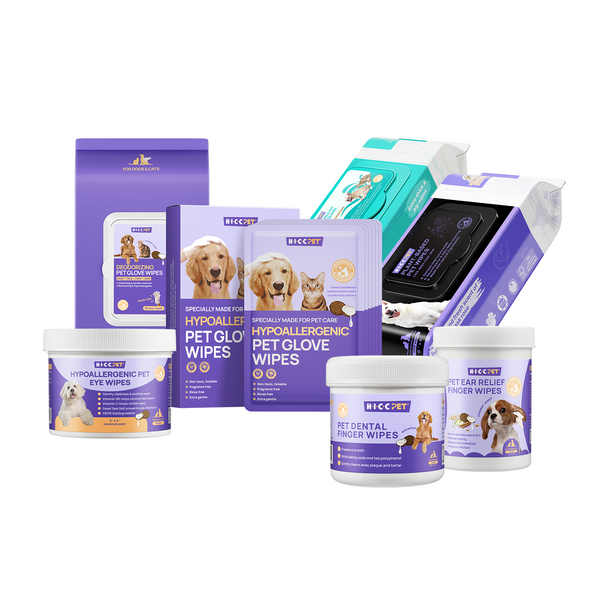With winter approaching, you dream of cozying up by the fire with your pooch or letting them run free in the snow. A white winter wonderland can be some dog’s favorite time to frolic but at the same time, it can result in increased dangers for your dog that often lay below the surface of that fluffy fur. Through this blog, we will go over how to keep your pets safe in the winter by ensuring they have proper protection, knowing the signs of hypothermia, and common winter health conditions to keep an eye out for in order for the winter season to ensure a safe and joyous winter season for all.
Keep Them Warm Outdoors

Dogs of varying breeds, sizes, and coat types will require different types of protective clothing from the cold winter and snow. Those dogs who are at higher risk in the snow might be:
- Small dogs
- Short-legged dogs
- Senior Dogs
- Dogs with Chronic Conditions
- Dogs with Arthritis
- Puppies
- Dogs with fine or thin hair
Breeds in these categories should often be protected when going outdoors in the snow as they are more susceptible to harsh conditions. Breeds that may fall into the higher risk category include chihuahuas, corgis, pugs, dachshunds, boxers, and other similar breeds. On the other hand, many dogs are built for the snow and harsh winter weather, often noted by a thick double coat. If you’re unsure what this is, breeds that fit this category include:
- Siberian Huskies
- Samoyeds
- American Eskimo Dog
- Alaskan Malamute
- Bernese Mountain Dog
For those dogs who don’t have natural protection from the cold, they might not need any kind of jacket unless it’s raining and you want to keep them dry.
If your dog shivers in the cold or fits one of the high-risk categories, you might want to consider getting them some warm clothing, like a sweater, vest, coat, or jacket. These are easily found in any pet store and online. With pet stores, you can at least try them on to ensure the proper fit. Most favored materials include washable wool or polyester fleece blends because they're cozy and easy to take care of.
Jackets and vests were originally made for working dogs that spent a lot of time outside in harsh conditions. The purpose of these garments was to keep the dogs warm, even in wet environments. Nowadays, neoprene is a popular material used in sporting and hunting dog vests and jackets as it provides insulation even when wet. Therefore, if you and your furry friend enjoy outdoor adventures in moist conditions, you should consider getting clothing made with neoprene.
Bring Pets Inside
Have you ever heard the phrase “If it’s too cold for you, it’s probably too cold for your pet?” Now, while this is generally true, one thing to also remember is that all breeds are built differently. Your chihuahua will definitely not be able to handle being in the cold for too long but a husky may refuse to move as delicate snowflakes cover their fur turning them into their own snowman. The following advice is general advice for dogs in the winter and the snow and the importance of bringing them inside (if they need to be).
When many dogs are left to freeze outdoors they can potentially become disoriented, develop hypothermia and so much more. If your dog happens to be an outdoor dog, we urge you to bring them inside for the winter season. Despite that advice, we know that there will be people who still keep their dogs outside. In order to still provide them the best care and keep them safe, it’s highly recommended to make a doghouse available to them that is dry and draft-free. This shelter should provide ample room for your dog to sit, lie down, and turn around comfortably without being too large in order to keep their body heat. The floor should be raised a few inches off the ground and covered with cedar shavings or straw along with the entrance facing away from strong winds and have a flap made of heavy waterproof fabric or thick plastic to keep out the cold and moisture.
Protect the Paws

Protecting your dog's paws in winter is crucial. Sidewalk and road salt, as well as other chemicals, can irritate and discomfort your dog's paws and paw pads. Regularly check for cracks in the paw pads and redness between the toes. Using booties is an excellent way to safeguard your dog's paws. If booties aren't an option, apply petroleum jelly or pet paw protection wax to all four paws before going outside. You can also trim the hair between your dog's toes to reduce the risk of iceball buildup.
When picking out booties, take into consideration that the ideal dog boots should be pliable, water-resistant, feature textured soles for traction, and come equipped with adjustable Velcro straps. Well-known brands like Kurgo, Ruffwear, SaltSox, and Muttluks offer quality options. To ensure a proper fit, consult size recommendations and measure your dog's paws before making a purchase. As many dogs are initially opposed to booties, consider introducing them indoors for short intervals. You can also ease your dog into the idea by starting with indoor dog socks, specially designed with a non-slip surface, which can be particularly beneficial for older or injured dogs seeking improved mobility.
Winter Pet Health Basics
The winter not only brings cold weather and snow but it can also bring on a myriad of season-specific health conditions. Many dogs experience skin dryness due to the cold, dry air and reduced humidity. This can lead to discomfort and itching for your furry friend. To help your dog avoid skin dryness during this season, it's essential to maintain proper grooming practices. Regular, gentle brushing not only removes dead skin and loose fur but also helps distribute natural oils that keep the skin moisturized. Bathe your dog with a moisturizing pet shampoo designed for their skin type and avoid over-bathing, as frequent baths can strip the skin of essential oils. For a quick refresh without the bath, use HICC Pet™Dog Freshening Grooming Glove Wipes which are deodorizing and moisturizing. Ensure your pet stays well-hydrated, as proper hydration is vital for healthy skin. Finally, provide a balanced diet rich in essential fatty acids, or consider supplements recommended by your veterinarian. By taking these preventive measures, you can help your dog maintain healthy and itch-free skin throughout the winter. For those dogs who are suffering from skin dryness and irritation, HICC Pet™ Dog Skin Care Relief Spray soothes irritations and offers fast itch relief for your pet.
Infectious diseases affecting pets, particularly respiratory infections, are a notable concern during the winter months. Cold and damp conditions can weaken a pet's immune system and make them more susceptible to respiratory illnesses. Canine influenza is a common illness brought on during the winter which further spreads during increased indoor type with multiple dogs. To help prevent illness, keeping pets warm is the priority. They should be kept warm and dry, have adequate bedding and shelter, and access to the indoors. Additionally, proper hydration and nutrition are crucial for maintaining a strong immune system. Regular grooming can also help keep your pet's fur in good condition, reducing the risk of cold-related stress.
Winter Hazards to Avoid

Winter can bring along various hazards outdoors, more so in the snow than in other types of cold weather such as rain. The unique challenges of snow and freezing temperatures require extra caution when caring for your pets. Here are some additional considerations to keep in mind:
- UV Rays: Many assume that you can’t get sunburnt in cold weather or overcast but just like humans, dogs can still get sunburnt from the harsh UV rays, especially those with light skin and fur. It’s important to remember that UV rays are stronger at higher altitudes.
- Salt and De-Icers: It's important to be aware that road salt and de-icing chemicals can cause pain and damage to your furry friend's paws. After taking your pet for a walk, it's a good idea to wipe their paws clean and consider using safe alternatives on your property to avoid any potential harm. We also suggest taking precautions by using boots on your dog and you learn more about the importance of boots in the snow further up in this blog.
- Antifreeze: The use of anti-freeze increases in the winter months and animals are attracted to the sweet taste which is poisonous and can be fatal easily if too much is ingested or not taken care of swiftly. Always keep it out of reach and clean up all spills ASAP.
- Cold Temperatures: During periods of extremely low temperatures, it is crucial to take precautions to protect your furry friend from hypothermia and frostbite. Creating a warm and secure shelter should be a top priority, and it is advisable to keep your pet indoors as much as possible during these chilly months.
- Frozen Bodies of Water: If you live in an area with ponds and lakes, keep your dogs away from them. We often see videos of dogs slipping and sliding on frozen bodies of water but what’s not shown is the high risk of these cracking resulting in potential drowning or hypothermia.
- Car as Hiding Spots: Cats often find warmth under cars and in car engines during cold weather but unfortunately this can often result in those cats’ demise. Before starting up your car in the winter, bang on the hood of your car repeatedly, check the tops of the tires, and check under the car.
Keeping your pet safe during the winter requires vigilance and attention to these potential hazards. By taking precautions, you can help ensure your pet stays happy and healthy in cold weather.
Preventing Frostbite and Hypothermia
An added risk of exposure to extremely cold temperatures hypothermia and frostbite. In order to prevent this from happening, ensure that your pet's outdoor excursions, such as potty breaks and walks, remain brief and enjoyable when the weather turns chilly. The dropping temperatures, ice, and snow make it unnecessary for your furry friend to spend extended periods outdoors. It's crucial to understand your dog's individual limits, as tolerance to the cold varies from one canine companion to another based on factors like coat, activity level, body fat, and overall health.
Typically, most dogs are comfortable until the temperature dips below 45 degrees Fahrenheit. However, when it falls below freezing (32 degrees Fahrenheit), it's important to exercise caution, particularly with smaller dogs, those with thin coats, very young or old dogs, or those dealing with health conditions. Dogs with diabetes, heart issues, kidney problems, or hormonal imbalances may struggle to regulate their body temperature, putting them at a higher risk of cold-related problems. When temperatures plummet below 20 degrees Fahrenheit, all dog owners should be vigilant, as there's a potential for health issues like hypothermia and frostbite. Recognizing signs of these conditions is essential:
Signs of Hypothermia in Dogs
- Shivering
- Lethargy
- Weakness
- Stiff muscles
- Pale gums
- Disorientation or stumbling
- Dilated pupils
- Low heart rate
- Low breathing rate
- Collapse
Signs of Frostbite in Dogs
- Discoloration of the affected area (appearing pale, gray, or bluish)
- Coldness when touched
- Pain when the area is touched
- Swelling around the affected area
- Blisters
- Skin ulcers
- Blackened or dead skin
Should your dog display any of these signs, seek immediate advice from a veterinarian.
In addition to these temperature precautions, remember never to leave your dog alone in a cold vehicle, as cars can act as refrigerators, trapping in the cold and posing a serious risk to your pet's well-being. Your pet's safety and comfort are paramount during the winter season.
Winter Activities

Whether your dog loves playing in the snow or the cozy indoors is calling your pet’s name, here are some tips on how to enjoy winter activities and keep everyone happy and healthy.
Tips for Safe and Enjoyable Outdoor Activities with Your Pets in the Snow
When enjoying outdoor activities with your pets in the snow, ensure their safety and enjoyment. Invest in doggy booties to protect their paws from cold and ice. Dress them in a cozy, insulated jacket or sweater. Keep walks and playtime short in extremely cold weather, and be mindful of signs of discomfort, such as shivering. Consider snow-friendly games like fetch or hide-and-seek to keep your pet engaged while enjoying the winter wonderland.
Ideas for Keeping Pets Active and Engaged Indoors
For days when outdoor play is limited, there are numerous indoor activities to keep your pet active and engaged. Interactive toys, puzzle feeders, and treat-dispensing toys provide mental stimulation. Set up an obstacle course or use indoor agility equipment for physical exercise. Regular playtime and positive reinforcement training sessions can maintain mental and physical health.
Benefits of Indoor Exercise and Play During the Winter
Indoor exercise during the winter offers various benefits. It keeps pets fit, reduces boredom, and prevents destructive behavior. Mental stimulation through puzzles and training enhances cognitive abilities. Additionally, indoor activities are not weather-dependent, allowing for consistent exercise and bonding with your pet.
Tips on Creating a Cozy and Pet-Friendly Indoor Environment
Winter is the perfect time to create a cozy indoor haven for your pet. Ensure your home is well-heated to keep your pet warm. Provide comfy bedding and blankets, and consider a heated pet bed for added comfort. Keep their favorite toys accessible for play, and maintain a routine of cuddle time to keep them feeling secure and loved. Finally, set up a designated space for your pet with their bed, toys, and a view of the outside world, ensuring they have a comfortable and content indoor experience during the winter months.
Conclusion
In conclusion, keeping your pet safe during the winter season requires a bit of preparation and awareness. By following the tips and guidelines outlined in this comprehensive guide, you can ensure your furry friend stays safe, healthy, and happy throughout the winter. Remember to provide proper protection, keep an eye out for signs of hypothermia and frostbite, and be aware of common health conditions that may arise during the colder months. With these precautions in mind, you and your pet can enjoy all the joys of winter without any worries.
Please note that the information provided in this article is for educational and informational purposes only. We are not veterinarians, and the content shared here should not be considered professional veterinary advice.
If you have any questions regarding copyrights or the use of materials in this article, please contact us for clarification.







Thanks for your interaction and support.